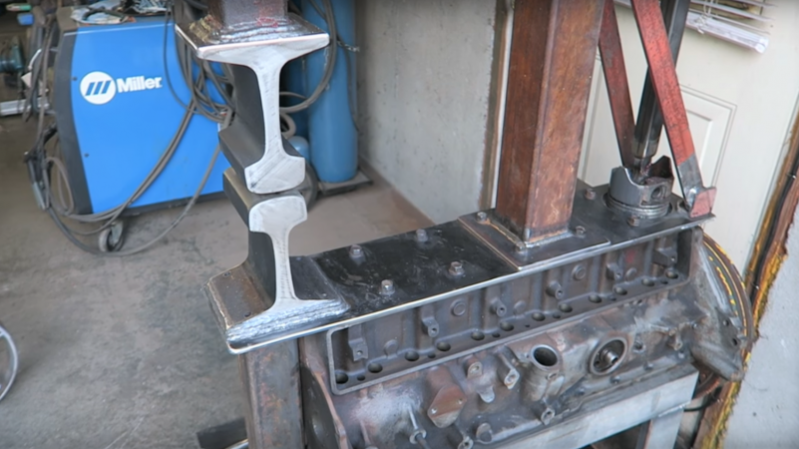Any way you look at it, blacksmithing is a punishing trade. Heavy tools, a red-hot forge, flying sparks, and searing metal all exact a toll on the smith’s body unless precautions are taken. After proper safety equipment and good training, a blacksmith may want to invest is power hammer to replace at least some of the heavy hammer work needed to shape hot metal.
Power hammers aren’t cheap, though, which is why [70kirkster] built one from an old engine block. You’ve got to admire the junkyard feel of this thing; it’s almost nothing but scrap. The engine block is a straight-6 from an old Ford pickup stripped of everything but the crankshaft and one piston. An electric motor spins the crankshaft and moves the hammer against the anvil through connecting rods and a trip arm fashioned from a trailer leaf spring. Everything looks super solid and the hammer hits hard; the videos below tell the tale of the build and show the hammer in action. Not bad for $100 out-of-pocket.
Blacksmithing is one of those dark arts that really deserves to have more adherents. The barriers to entry can be high, but the rewards are great. Looking to get started on the cheap? Then check out [Bil Herd]’s guide to hacking together a backyard smithy.
https://www.youtube.com/watch?v=0OrPz7vDfvY
https://www.youtube.com/watch?v=H_vuf_ObjO4
















Wonder what the time is to becoming proficient?
As someone with some experience in both, I’d say it’s like music. Some depends on aptitude, but no matter how good you are, there’s no limit on getting better – so, never boring unless you allow it to be. But then, there’s always the case of no matter how tricky you are with a shovel, along comes a bulldozer and does some things better than you ever will (John Henry). Or Jimi Hendrix after you thought you knew all that was in a guitar – in the latter case, it’s not so much advancement in the tools as in conception.
We have a saying: for the first two years you’re always making the same thing: scrap metal. ;)
Fabulous build! That’s ~500lbs of steel that won’t see the scrap-heap. Thank you for sharing!
Now I need to keep my eyes peeled for an old I4 or I6 engine :)
I was under the impression (which may be incorrect) that cast steel doesn’t generally take well to impacts such as well, what this machine is designed to do?
Cast steel does great if it’s a good alloy / heat treat it makes up the best anvils out there. Certain alloys of cast iron are very brittle others can be quite serviceable.
I guess what I am asking is more along the lines of if it is reasonable to expect an engine block type of cast material to be likely to hold up well to being used as an anvil. Seeing them crushed in, well, large crushers doesn’t make me confidant in how many of them they fail under substantial pressure or impacts.
Most of the impact appears to be taken by the vertical tube directly under the hammer. I suspect that the engine block will see vibration, but not a lot of actual impact force.
Cast steel takes impacts just fine, it’s cast iron that isn’t necessarily a fan of it. That being said, the bodies of older much more powerful industrial hammers were made from cast iron, so it shouldn’t be a problem.
Is that foot control just a pulley tensioner? I wonder how the belt will hold up.
My thoughts too. Not that they’re terribly expensive.
I wonder how it would go using a clutch instead. Leave the flywheel and clutch intact, and back-drive the motor from the clutch’s output shaft.
Probably like the commercial versions.
You might find an outboard motor clutch in a few junk yards. Lots of ‘Appalachian’ power hammers use a spare tire as the flywheel and clutch. There’s a few models that use a cone clutch either commercially made or cobbled together.
But now you’re adding parts and expense.
It very common for small engine service such as riding lawnmowers, rototillers and such. My guess is the belt will outlast the stress fractures in the engine casting and the welds
https://www.youtube.com/watch?v=-tPTLwmxsWc
Here’s someone making one twas in the list.
Keep your dick out of the forging hammer.
Nice use of a He/AMC engine block.
Well done. Not an easy build to undertake. It seem to work fairly well, seeing its first run. It does seem to lack a little power(or maybe more heat in your material), but a heck of a lot better than pounding your guts out.
If you had a round bar attachment for the bottom anvil it may make drawing material out a little easier.
I like it.
Very nice build. :)
“The engine block is a straight-6 from an old Ford pickup”
That was probably the good old legendary Ford 300 inline 6, which was an engine known for it’s durability and impressive torque. they made these engines for 31 years straight and put them in everything from pickups to dump trucks, including quite a few delivery vans used by companies like UPS. Anyway, nice build
“Special thanks goes out to my nephew Charles for donating the engine. I don’t think there was anything wrong with it!”
Still, he could’ve used a broken block. There’s not going to be more of those blocks, atleast not until 3D printing can print metal strong and cheaply enough. Might not happen fast enough though.
I can’t approve this.
Any other videos on this type of build?